Production Year 2021
The flowers of My Town The current lives of The Geigis of Niigata
DC282180![]()
おらがまちの華 柳都で生きる芸妓はいま [BSN]
![]()
![]()
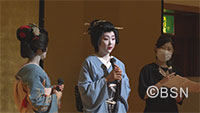
|Length : 49min |Year : 2021 |
Aoi is a Furumachi Geigi working in Furumachi, Niigata, also known as the land of willows.
Now in her 16th year, Aoi is one of the most renowned veteran Geigi in Furumachi.
Her career stretches widely; she has lectured seminars, appeared on local television, and has even published a book of her magazine column.
The young Furumachi Geigis currently work for Ryuto Shinko Inc, the nation’s first company focused on training and managing Furumachi Geigis.
Aoi was the first ever Geigi to leave Ryuto Shinko Inc. to become an independent Geigi.
6 years after becoming independent, the global pandemic hit, and Aoi’s fear for the Furumachi Hanamachi’s future grew rapidly.
Rather than waiting for the spread of COVID-19 to slow down or for the ozashiki events to return again, she felt it was crucial for the Geigis themselves to do something.
Aoi decides to convince Ryuto Shinko and the young Furumachi Geigis to try and market Furumachi Geigi more broadly to the public, and start a branding structure with them.
Her motivation is her love towards Furumachi Hanamachi, and her seniors who protected the traditions of the Geigi culture and raised Aoi to be the Geigi she is today.
What can Aoi do to help keep ozashiki events and the Hanamachi culture of Furumachi Geigis alive? Will Aoi’s aspirations resonate with the younger generation to help bring a brighter future for the Furumachi Hanamachi?
We follow Aoi to see the past, present, and future of the Furumachi Geigi culture.
 A Passionate Challenger | Sakuramori
Guardians of Sakura Cherry Blossoms
A Passionate Challenger | Sakuramori
Guardians of Sakura Cherry Blossoms
DC282181![]()
吉野山桜守 伊藤将司・山口公佑・奥西信介 [MBS]
![]()
![]()
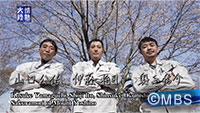
|Length : 25min |Year : 2021 |
Standing proudly in the heart of Nara Prefecture is Mount Yoshino, a World Heritage Site and one of Japan’s top three sakura cherry blossom sites. The view of 30,000 cherry trees blossoming over 50 hectares of the mountainside in spring is simply breathtaking.
People who care for cherry trees are known as “sakuramori” or “sakura guardians.” At Mt. Yoshino, three men are in charge of this responsibility: the captain Ito, a native of the Yoshino area; Okunishi, a former landscaper; and the always cheerful Yamaguchi.
Sakuramori have a wide range of duties, including picking cherry tree seeds, planting them, growing saplings, planting trees, cultivating soil, weeding, and at times, treating trees that have fallen ill from getting damaged by wild deer. If cherry trees are children, then sakuramori are everything from parents to doctors.
The sakura are in full bloom for a mere week, and the sakuramori devote an entire year all for these seven or so days. Captain Ito says, “The more work we put in, the sakura answer to us and bloom beautifully.”
Every year, Mt. Yoshino is flooded with tourists during sakura season, but last year was an exception due to the State of Emergency. Even Ito, born and raised by the mountain, had never seen the area so empty. “We’re hoping that this year, people will get to see the sakura that we care for, and perhaps bring a bit of joy to this gloomy world” say the three cherry tree guardians. Come witness the story of the sakuramori.
Artist of Divine SpiritMiwa Komatsu and Tears of the Earth
DC282182![]()
神獣アーティスト 小松美羽と地球の涙 [HTV]
![]()
![]()

|Length : 23min |Year : 2021 |
A contemporary artist Miwa Komatsu who is active overseas and her drawings are receiving a lot of attention.
One of the most famous museums in the world, the British Museum has selected her painted Arita porcelain guardian dogs as a part of its permanent collection. She is now one of the hottest contemporary artists in the world.
It is her unique style that attracts people. She delivers prayers to people by drawing sacred beasts such as mountain dogs, dragons, and phoenixes that only she can see.
Miwa Komatsu visits the A-bombed area of Hiroshima. What does she feel with her unique sensitivity and her view of life and death, facing the A-bomb survivors and relics?
Kaka Murad The Japanese water doctor, Nakamura Tetsu
DC282183![]()
カカ・ムラド 中村哲の信念 [TNC]
![]()
![]()
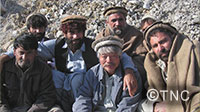
|Length : 47min |Year : 2021 |
“One canal willdo more than100 medical clinics.”
In his lateryears,the doctor ofmedicinewore more overallsthan whitecoats,
and wielded an excavatorinstead ofa scalpel, allto bringwaterto those
suffering froman unprecedenteddrought 6,300 kilometers away fromhis
Japanese homeland, andto turnAfghanistan’sparched land green.
Aimingto bring peace without weapons, and devotinghis effortsto the support
ofrefugees, he wasknown to the localsas“KakaMurad,” meaning“Uncle
Nakamura.”
Usingconstruction methods that enabledthe localsto make their own repairs, he
had a habit ofsaying, “My successor is the canal itself.”
His words came true, andthe product ofhis beliefs nowflowsthroughoutthe
once-parched land.
Why didhe devotehis life to rebuildingAfghanistan?
What exactly wasitthat spurred himinto action?
We search foranswersinhis hometown, and theDNAhe inheritedfromhis
grandfather. TelevisionNishinippon’s archivesand exclusive newfootage fromAfghanistan
provide a look at thelife ofDr. Nakamura Tetsu.
Tech Innovators in Japan~①Magic Paint that Shields the Streets ②Keeping Tradition Alive with Kaya from Aso
DC292143![]()
世界一の九州が始まる!①道を守る水性ペイント②伝統文化つなぐ阿蘇のカヤ [RKK]
![]()
![]()
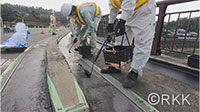
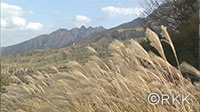
|Length : 24min |Year : 2021 |
1. Japan's transport infrastructure, in particular roads and bridges, was mainly built in the country's rapid economic growth decades. However, problems of infrastructure aging and scenery maintenance are causes of concern for citizens and civil authorities. Kumamoto construction company Amaken Tech has stepped up to help resolve these problems with a revolutionary new paint. This water-based paint is non-toxic and scentless, yet is strong against abrasion. It’s a revolutionary new option for the road construction industry, which still uses enormous amounts of long-lasting oil-based paint. In this half of the program, we investigate the traits and technology of this paint, which is finding its way onto roads all through the country.
2. Constructors of traditional Japanese buildings have a big problem: where do they get the kaya grass to replace kayabuki thatched rooves? Kaya growers are decreasing in number, as are the grasslands where one can harvest kaya. Meanwhile, in Aso, volunteers are gathered each year to burn down kaya grass to maintain farmland.
Yasutaka Yamamoto from the Aso-based GS Corporation has started a new business, purchasing kaya grass harvested before burns, to be sold to kayabuki craftsmen in Kyoto. It’s helping to provide income to farmers in the off-season, and motivation to protect Aso’s grassland. In this half of the program, we talk with Yamamoto about his work to protect traditional architecture, and meet the people of Aso helping to gather and maintain kaya grass.














